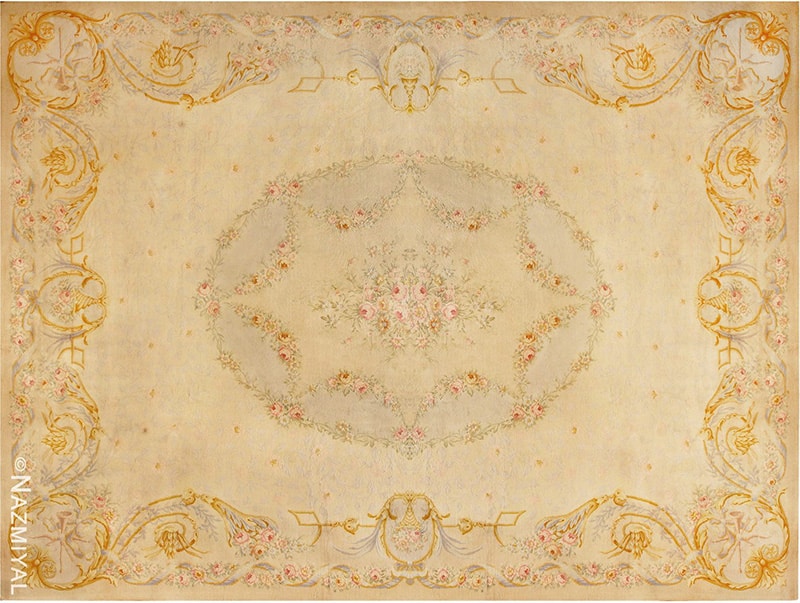From Rococo Rugs and Tapestries To Rococo Art and Interiors
Nothing says elegance and decadence like the breathtaking Rococo rugs and artwork of the Rococo Period which spanned from the late 17th century through the early 18th. This style of artwork was prevalent in the 18th century in continental Europe. Some art historians have difficulty drawing the line between when the late Baroque Period ended and the Rococo Period began. The artwork of this period is known for its lavish asymmetrical patterns, intricate motifs, romantic subject matter and highly developed scroll work.
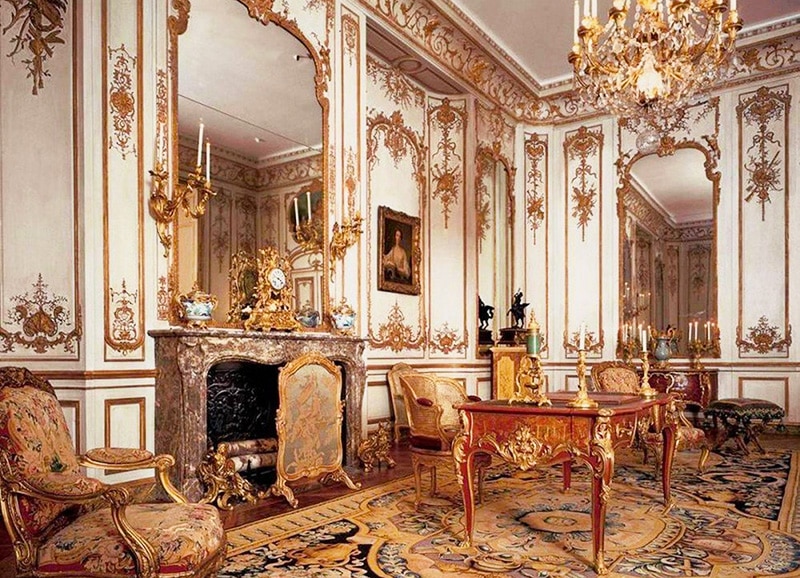
French Rococo Interior Design
Early Rococo design began in Paris and later spread throughout the rest of France and beyond. It became especially popular in Germany and Austria. The grand geometric and curvy designs of Persian carpets fit well into this style and became important elements of the interior design.
What does the word Rococo mean?
The word “Rococo” refers to a style of art and architecture that emerged in the 18th century in Europe, particularly in France. It is characterized by its ornate and highly decorative nature, featuring intricate designs, curves, and lavish embellishments.
The term “Rococo” is believed to have originated from the French word “rocaille,” which means “rock-work” or “pebble-work.” It reflects the influence of natural forms and motifs, such as seashells, rocks, and scrolls, which were commonly used in the decorative elements of Rococo art and design.
Rococo developed as a response to the more formal and restrained Baroque style that preceded it. It emerged during a period of relative peace and prosperity, known as the Age of Enlightenment, when the arts and culture flourished in Europe.
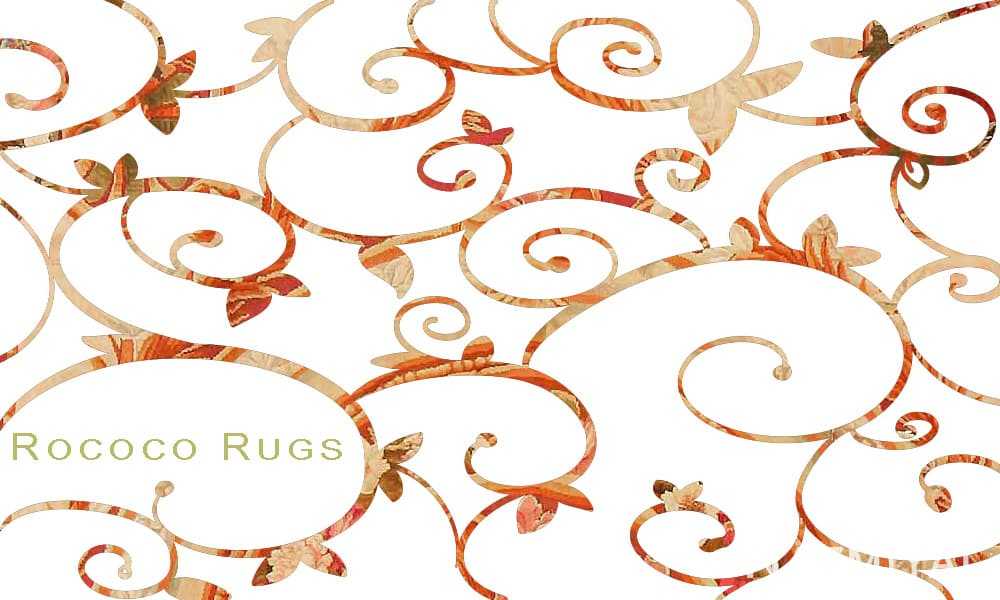
Rococo Area Rugs, Tapestries, Art And Interiors
Rococo art and architecture emphasized grace, charm, and delicate beauty. It featured asymmetrical compositions, flowing lines, and intricate details. Common motifs included swirling foliage, flowers, playful cherubs, and romanticized pastoral scenes. These motifs were often incorporated into various forms of artistic expression, including painting, sculpture, architecture, furniture, and interior design.
Rococo style was favored by the French aristocracy and quickly spread to other European countries, including Germany, Austria, and Italy. It found expression in the design of palaces, salons, and grand residences, as well as in smaller decorative objects and personal possessions.
The Rococo era was associated with luxury, elegance, and a certain lightness of spirit. It was criticized by some for its perceived frivolity and superficiality, but it also represented a departure from the rigid and formal traditions of the past. The style eventually gave way to the neoclassical movement, which sought inspiration from ancient Greek and Roman art.
Today, the term “Rococo” is commonly used to describe a specific artistic and architectural style that flourished during the 18th century. It serves as a descriptor for works that exhibit the characteristic features and aesthetics of the Rococo period, embodying a sense of opulence, intricacy, and decorative exuberance.
Persian Rugs in Rococo Interior Design
During the Renaissance, a thriving trade was developed between Persia and Europe as result of the promotion of the arts by the Safavid rulers. Persian rugs came to play an important role in the world of eastern and western interior design, particularly among the wealthy class. They were a symbol of wealth and prosperity. Historical documents and wills of private estates indicate that Iranian textiles and carpets were important commodities in the international marketplace.
The marketing of Persian carpets to Europe led to the development of bilateral commercial relations and extensive trade networks. These relations involved regular diplomatic exchanges and often Persian rugs were gifted as part of these exchanges. The goal of both parties was to preserve their commercial interests.

Rococo Style Interior Design With Persian Rug
The fine silk produced by Persian carpet weavers became the luxury carpets marketed to the highest courts and wealthier classes in the European market. However, in the 18th century, international trade was disrupted by political instability. Imports from Europe threatened to upset the long standing Persian rug trade that began with the Safavid rulers.
During this time, floral and garden design patterns were popular as a way to bring the warmth and beauty of the garden to drawing rooms, bedrooms, parlors, and dining rooms. They were often given as wedding gifts that represented a lasting treasure to be handed down through the generations. The Rococo period Persian rugs of the 18th century continued to use many of the patterns developed by the Safavid artists. During this time, Kerman became an important carpet making and trading center. The raw wool from Kerman livestock became an important export commodity as well. Trading houses were also established in Tehran, Tabriz, Isfahan, and Mashhad.
French Rococo Rugs Compete With Persian Carpets
In 1722, the Afghans invaded Persia and occupied Isfahan. This ravished the Safavid dynasty and brought it to a halt. Trade was stopped and so was the export of Persian Carpets to the European markets. By this time, the French carpet works at Savonnerie had been in operation for approximately 100 years and were ready to step in and provide carpets to fill the gap created by the invasion of Isfahan. They produced lavishly designed carpets that complimented the Rococo style which was continuing to develop and grow in popularity.
Carpets produced at Aubusson France are known for their Rococo style scroll work. The Aubusson weavers produced the characteristic designs that flourished in French artwork and interior design. Many of the carpets were still inspired by the Persian carpets, with a structured border and field design. Sometimes, they incorporated the medallion design that became popular in Safavid Persia, but their motifs took on the distinctive Rococo flourishes and leaf patterns. These carpets became the new trend in European interior design.
During this time, Persian carpets would never completely go out of style and were still exported to some degree.That said, they now had competition from the French carpet makers and the English. The Persian carpet industry would not experience a revival until the mid-1800’s. For a time, the elegant late Baroque and Rococo designs coming out of France would dominate the market.
Madame Pompadour and the French Court
Much of transition from the late Baroque style to classic Rococo style was influenced by Madame Pompadour and the reign of Louis XV. At that time, the women wore wide panniers draped with many yards of material. It was a world of extremes in fashion and interior design. Fine silks were favored, and the idea of ornamentation rose to a new level of extravagance.
Deeply carved flowers, roses, leaf swirls, seashells, and scrolls dominated artwork, textiles, and furniture making. These elements also showed up in the carpets woven at the time too. Rococo style became the iconic symbol of the wealth and decadence of the French courts. Rococo rugs brought the style from floor to ceiling. The carpets often mimicked the ornate ceiling frescoes and moldings in architecture of the time.
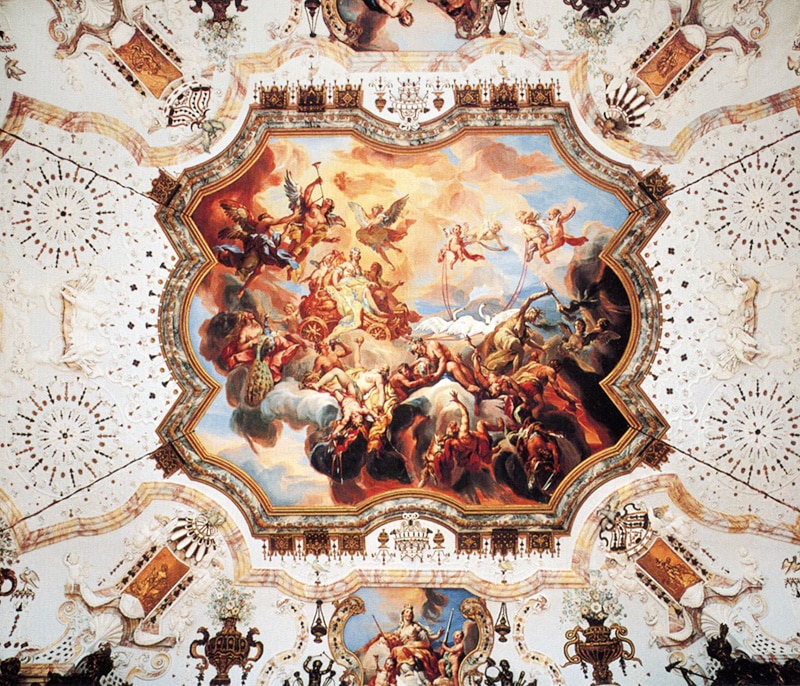
Elaborate Rococo Ceiling Frescoes
Kerman in Persia continued to represent an important center for carpet exports. Carpets produced in the area have intricate, finely detailed designs that fit well into Rococo design ideology. Kerman rugs were often made of silk and retained a metallic shimmer. They featured ornate floral and leaf patterns that complimented the designs being produced in France and other European carpet centers. Many of the rugs produced in Aubusson mimicked the Kerman rugs, but added their own unique details and flourishes that make them easy to distinguish from true Persian rugs.
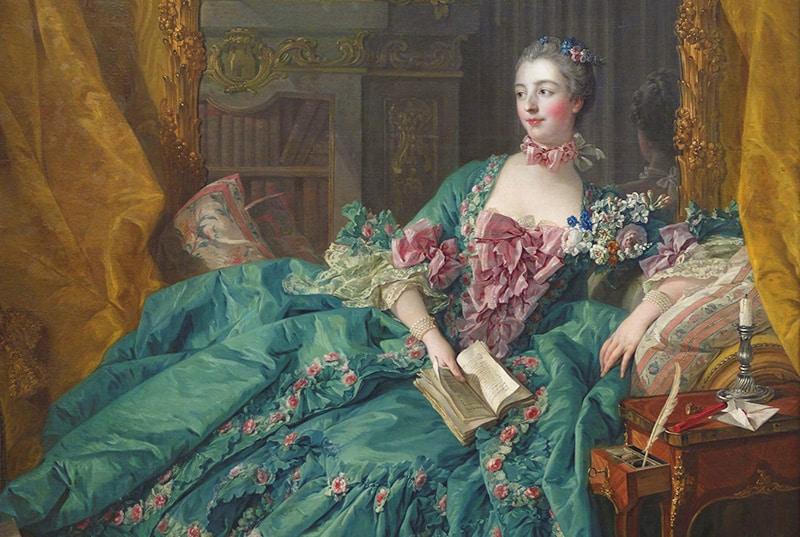
Portrait Of Madame Pompadou
Carpet makers at Savonnerie would sometimes produce rugs with a mihrab and intricate borders. They may not have known that the mihrab was a representation of a mosque and they were simply copying a familiar design that they had seen. One can also find many medallion rugs being produced by the French carpet manufacturers. One difference between the French carpets and those produced in Persia is that French carpets often have open background in the medallion and field, rather than being filled with vines and lavishly flowing floral patterns. The French carpets also tend to have more subdued colors and make greater use of pastels.
The 19th Century Rococo Revival
The Rococo Period was a reaction of the court of Louis XV to the more angular, geometric designs of Louis XIV. The style began approximately 1730 and lasted until the 1760’s. However, in the early 19th century, it experienced a revival. The revival of the Rococo style spread from France to England and later throughout Europe and to The USA. Actually, several waves of Rococo revival can be seen. This style seemed to periodically reoccur during several time periods. These revival periods were spread from the 1830’s through the 1940’s and appeared in different places around the world at different times.
Designers of carpets and furniture continued to look to Rococo design for inspiration. It is not uncommon to find Rococo style rugs or rugs that have familiar Rococo elements throughout the 19th and 20th centuries. During the Art Deco Period of the 1920’s, a simplified version of Rococo designs began to appear. The scroll work was similar, but it often only existed in outline form, or as a simple silhouette.
Rococo rugs are easy to recognize from their elaborate designs and scroll work. Although many Persian rugs were still being produced and exported, the fall of the Safavid dynasty presented an opportunity for French carpet makers to fill the void, and they did.
There is no denying the elegance and beauty of the antique rugs of the Rococo period, and some still manage to find their way into private collections and onto the open market. Rococo rugs of the 18th century are right at home with ornate furniture that includes elaborate carvings and cabriole legs. They continue to add a touch of elegance to any space and are perfect for formal settings.
Be sure to browse around and explore at our ever-changing collection of Rococo rugs for your space.
Antique Carpets Reminiscent of Rococo Paintings At Morgan Library
The following are three exquisite antique carpets from Nazmiyal’s collection inspired by three highlights from The Morgan Library’s latest exhibition of Rococo works, up through May 14th, 2017. The subtle pairings of palette and context bring together these three pairings harmoniously.
1. Oversized Antique French Savonnerie Rug, circa: 1900 (sold) & Francois Boucher’s Leda and the Swan, 1741.

Oversized Antique French Savonnerie Rococo Design Rug

François Boucher Painting – Leda and the Swan
See how the shades of red in the painting match that of this French rug. Notice how the strong sunlight gives a similar golden tone to Leda and her companion as the golden detail of the carpet. The luscious splendor of these two creations are also similar in their floral detail.
2.Our Vintage French Art Deco Carpet, Circa: 1920 & Francois Lemoyne’s The Farewell of Venus and Adonis, 1729.
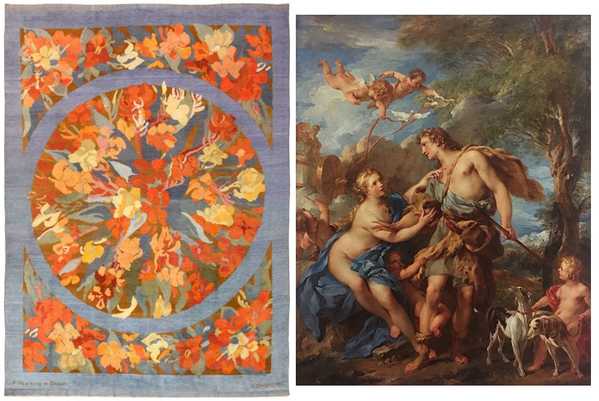
Vintage Art Deco French Rug, Nazmiyal Collection
Art Deco meets Rococo beautifully in the color similarities of bold, rich blues, and warm tones found in both of these pieces.
These two gorgeous works from two different countries come together through their soft blues that speak of a lullaby, and enchanting gold details that flow outward from the center of both the Antique Persian Kerman Carpet and Rococo painting.
This art and carpet blog that talks about Rococo rugs, tapestries, history, art and interiors was published by Nazmiyal Antique Rug Gallery In NYC which is located in the Heart of Manhattan, New York City.

